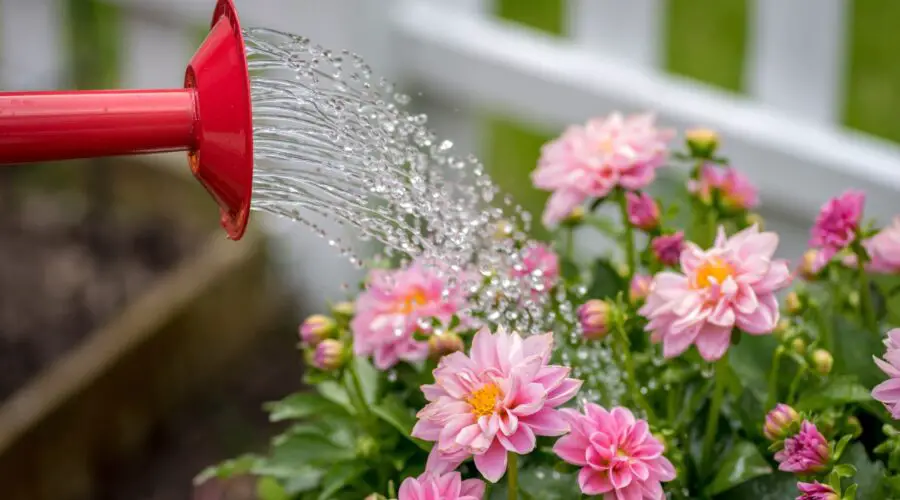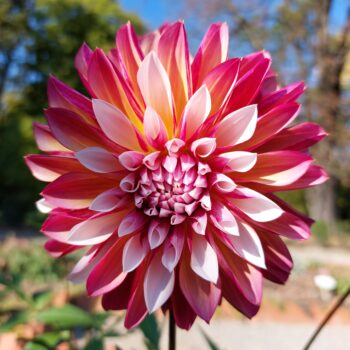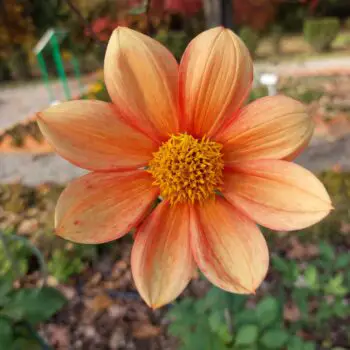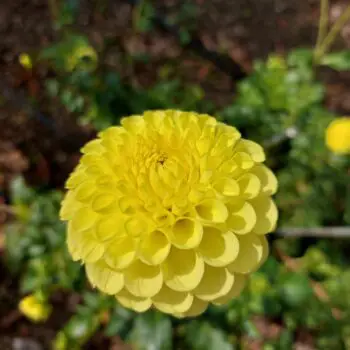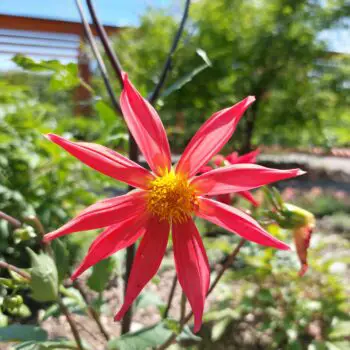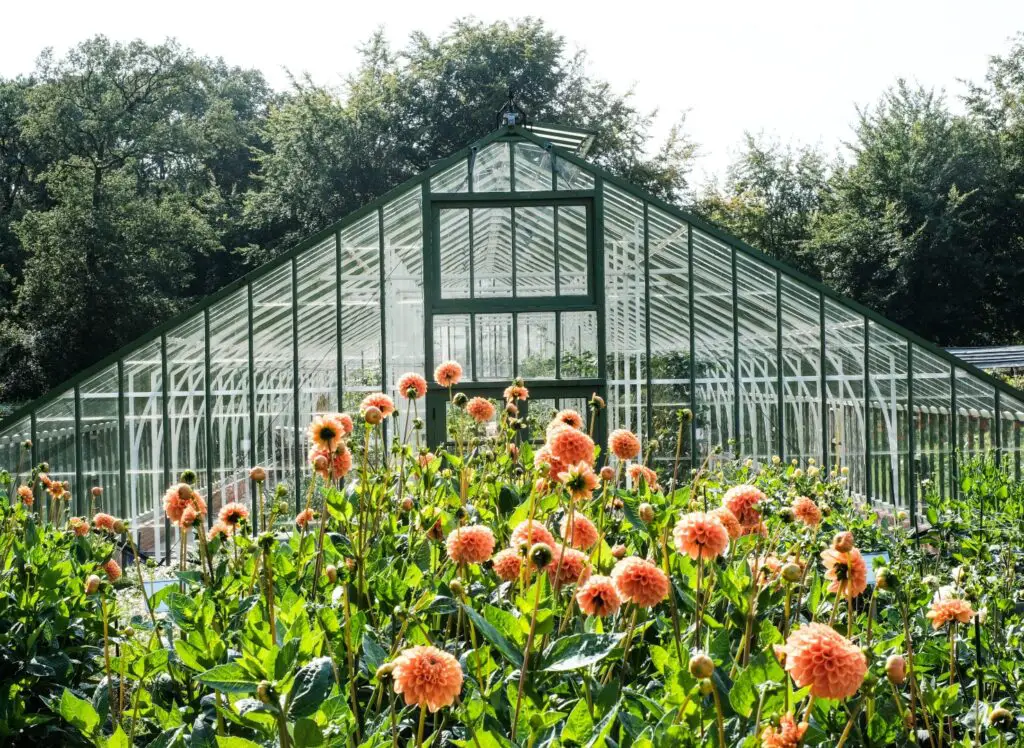A Guide to Growing and Caring For Dahlias
Dahlia flowers are exquisite with their unique petal arrangement and exquisite colors, making them a beautiful addition to gardens and flowerbeds. If you’re interested in adding these mesmerizing plants to your planting list, here is everything you should know about growing and caring for dahlias!
All About Dahlias
Dahlias are a member of the popular Asteraceae family, which also includes the daisy, chrysanthemum, sunflower, zinnia, and aster. Plants originate from Mexico and Central America and bloom in various colors and sizes.
The Many Different Types Of Dahlias
We’ve all wandered through the aisles at our favorite garden center, looking at the bags and bags of different dahlias, and were likely astonished at all the different ones. Surprisingly, more than 57,000 dahlia cultivars are registered through the UK’s Royal Horticultural Society.
The interesting part is that there are only 42 different species of dahlias. Unlike most plants with two sets of homologous chromosomes, every dahlia has eight, so there are significantly more genetic possibilities.
14 Different Divisions of Dahlias
To help organize the sheer number of cultivars, different organizations have tried arranging the flowers into groups based on their characteristics. This method still creates a great deal of confusion as associations vary in their approach, especially when considering international standards.
The UK’s National Dahlia Society (NDS) Classification is one of the most commonly recognized systems worldwide and groups plants into fourteen different divisions.
- Group 1: Single-flowered Dahlias
- Group 2: Anemone-flowered Dahlias
- Group 3: Collerette Dahlias
- Group 4: Waterlily Dahlias
- Group 5: Formal Decorative Dahlias
- Group 6: Ball Dahlias
- Group 7: Pompon Dahlias
- Group 8: Cactus Dahlias
- Group 9: Semi-Cactus Dahlias
- Group 10: Miscellaneous Dahlias
- Group 11: Fimbriated Dahlias
- Group 12: Star Dahlias
- Group 13: Double Orchid Dahlias
- Group 14: Paeony Dahlias
Are Dahlias Considered Annuals or Perennials?
Technically, dahlias are considered tender perennials. In the gardening world, this means it’s complicated.
In warmer areas that don’t get too cold in the winter, you can grow them as perennials and leave them in the ground all year. However, in the regions that experience colder temperatures, you need to dig the tubers up in the fall to protect them from freezing temperatures. Store them indoors over the winter and plant them again the following year.
How Big Do Dahlias Get?
Most plants grow to a mature height of 4 to 5 feet (1,2 to 1,5 m). The blossom size varies considerably depending upon the cultivar you are growing. Flowers can range from demure 2-inch (5 cm) wide pompoms to breath-taking blooms that span 15 inches (40 cm) in diameter.
When and How Long Do They Bloom?
One of the reasons gardeners love to grow dahlias is the plants put out show-stopping blooms for a long time. After planting, it may take about eight weeks for the plants to start flowering (typically late June to early July), but they continue to bloom until the first hard frost of the fall. In many areas, this can be a 4-month period.
Growing Requirements of Dahlia Plants
What Kind of Climate Do Dahlias Prefer?
Dahlias love moist, moderate climates where they aren’t exposed to temperatures extremes. They also need a reasonably long season where they can be in the ground for at least 120 days.
- Plants are winter hardy in USDA growing zones 8 to 11.
- Plants may survive in USDA growing zones 6 and 7 if conditions are mild or some insulation protects the planting bed.
- Plants should be treated as annuals in USDA growing zones 5 and below, or you should dig up the tubers once the first frost occurs and store them inside through the winter.
What Kind of Soil Do You Need?
Dahlias grow from tubers, which are thick, fleshy underground storage parts similar to bulbs. But unlike bulbs, tubers are not covered in papery “leaves”, so they are very susceptible to excess soil moisture. To keep dahlia tubers from rotting, plants like loose soil that drains well and doesn’t hold much water.
They also prefer slightly acidic soils (pH between 6.0 and 7.0) with plenty of nutrients to feed their beautiful blooms.
How Much Sun Do Dahlias Require?
Like many other flowering plants, dahlias want what is known as full-sun exposure, where they get more than 6 to 8 hours of sun every day—the more sun they get, the bigger and more beautiful their blooms. However, when they are exposed to great lengths of intense sun (12-14 hours), you will start to see the flowers fade quickly from heat stress.
If possible, plant them in a spot where they get a slight reprieve from the sun and heat during the most intense part of the afternoon.
What Is the Best Way to Start Dahlias?
If you’re new to growing dahlias, you can start new plants by either planting seeds or buying tubers. Seeds are considerably cheaper to purchase, but you must understand how the two methods differ in genetics and reproduction.
- Using tubers is a method known as asexual propagation, similar to taking plant cuttings. Once plants sprout, they are identical clones, so you’ll know exactly what flowers you’ll get.
- Using seeds to grow plants relies on sexual propagation. Each seed gets its genetic information from both parents, so the plants may not be identical, and you can’t control what flowers sprout and grow.
Starting Dahlia Plants From Seeds
Starting dahlia seeds is a great way to grow many plants and don’t mind various flowers. If you live in cooler climates, you’ll want to start them indoors about six to eight weeks ahead of the last frost-free date for your area. Then you can transplant seedlings outside.
- Premoisten potting soil and use it to fill your containers or seed starting trays.
- A few inches apart, poke small holes in the mix with a dowel or pencil.
- Set one seed in each depression about ¼ inches (0,6 cm) down, and gently cover each seed with potting soil.
- Mist the containers or seed trays with a spray bottle and cover them with a clear zip-top storage bag or the tray’s clear plastic dome.
- Move the containers someplace warm, like on top of the refrigerator, or use a seed starting mat.
Caring For Your Newly Sprouted Seedlings
- Keep the potting soil damp without letting it become soggy or waterlogged.
- After the seeds germinate, remove the plastic coverings and move the containers where they can get full sun.
- Once the seedlings unfurl the first set of true leaves, their roots grow rapidly. After a couple of weeks, you’ll want to repot them into larger containers.
- Continue caring for your seedlings inside until you can safely move them outdoors.
Preparing Your Dahlia Seedlings for Transplanting
Before transplanting your seedlings outside, you need to acclimate them to outdoor conditions, so they don’t experience transplant shock due to the light and temperature differences. This is known as “hardening off”.
A week or ten days before you want to transplant the seedlings, start moving them outdoors to a sunny spot for periods. Each day gradually increase their time outside, bringing them indoors at night until it’s time to transplant.
Step-By-Step Guide to Planting Dahlias
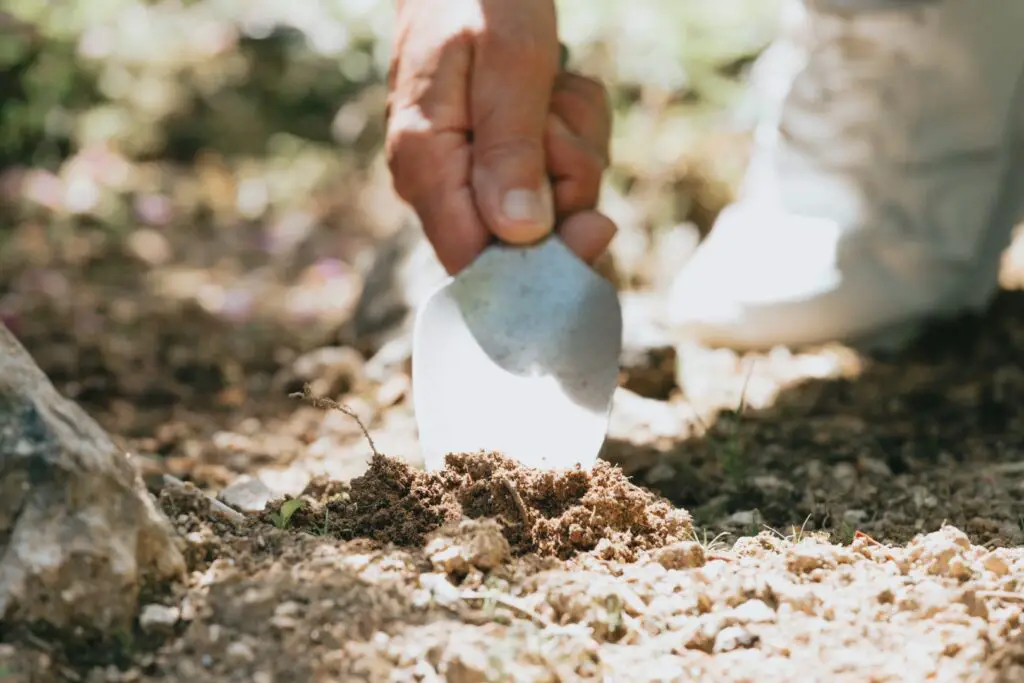
When Can I Plant Dahlias Outside?
Your exact planting date will vary from others because it is based on your growing zone and the possible danger of frost. The recommended timing is when soil temperatures are at least 60°F (15 °C), and the threat of spring frost has passed. In most areas, the climate is suitable for planting from mid-April to early June.
If you live in a warm climate, you may be tempted to plant earlier but try to wait until the soil temperatures are high enough. Dahlia tubers dislike cool, moist soil and may rot if planted too early.
Direct Sowing Dahlia Seeds
Direct sowing seeds is pretty straightforward. Unlike some flower or vegetable seeds, one doesn’t need to soak the seeds before planting. Sow seeds about ⅛ to ¼ inch (0,3-0,6 cm) deep with two seeds per 12 inches (30 cm) and 18 inches (45 cm) between rows. Gently pat the soil above the seeds to ensure good soil contact.
Once the first set of true leaves appears, thin plants to one every 12 inches (30 cm).
Do I Soak Tubers Before Planting?
Some gardeners like to soak their tubers before planting to help speed up sprouting, but there are mixed opinions on this practice. They need very little moisture to break their dormancy, so soil moisture should be enough. But if you soak them, don’t soak them any longer than an hour since they are prone to rot.
Ideal Plant Spacing and Planting Depth for Tubers and Seedlings
For most varieties, plant tubers and seedlings 12 inches (30 cm) apart with 18 inches (45 cm) between the rows.
- Plant tubers 4 to 6 inches (10-15 cm) below the soil surface with the eye facing upwards.
- Plant seedlings so the top of the potting soil is even with the ground.
It may seem like your plants will be spaced too far apart, but as they grow and mature, the space does fill in considerably. The 12 inches (30 cm) spacing between plants gives plenty of room for flower and foliage growth and lets air circulate through the plants. When airflow is constricted because plants are too close, you’ll have more pest and disease problems.
Caring for Dahlias
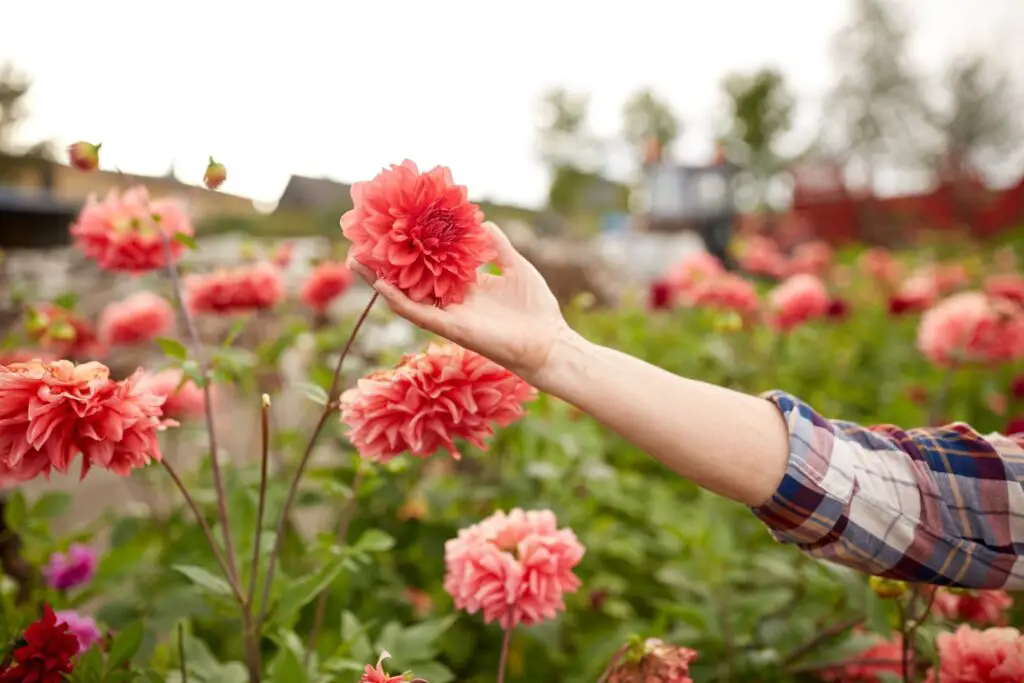
Watering Correctly to Prevent Rot
As dahlias have a fleshy tuber underground, they need to be watered differently than most plants to avoid rot. When you plant tubers, you can hold off watering until the first set of true leaves form—there’s typically enough soil moisture to sustain growth. Once the leaves form, water the ground around the base of the plants deeply but infrequently to keep the soil damp without being soggy.
Fertilizing Your Plants for Healthy Growth
About a month after planting, start feeding your dahlias every four weeks with a water-soluble high-quality low-nitrogen fertilizer. Or fertilize every two weeks at half the strength recommended on the product label.
You want to avoid too much nitrogen since it encourages foliage growth and fewer blooms. Using a fertilizer higher in phosphorus and potassium will strengthen tuber growth while promoting bigger blooms.
Avoid Mulching Around Plants
Unlike many other bedding ornamentals, this is one time when you should avoid mulching around the base of your plants. In many cases, mulch attracts problems like snails and slugs, and dahlias prefer the sun directly on the soil above their roots.
Staking Young Dahlias To Prevent Stem Breakage
Dahlia plants benefit from extra support, especially varieties with dinner-plate-sized flowers. These heavy flowers can cause the stems to snap if it’s windy or rainy. It’s best to stake plants when you plant them instead of trying to work with larger plants. Drive one or two metal stakes into the ground a few inches from the tuber, and then secure the dahlia stems to the supports as they grow.
Pinch Your Plants Back for Fuller Growth
Pinching plants is similar to deadheading them, yet different at the same time. When you pinch plants, you want to remove the top of the main stem to improve growth. Here’s an explanation of why.
Dahlias produce a central stem with a terminal bud at the very top. Removing this bud triggers the plant to grow outward (i.e., bushier) instead of only upwards and encourages bud development. You’ll end up with fuller, stouter plants and more flowers.
When plants are 12-18 inches (30-45 cm) tall and have four sets of leaves on the central stem, use your fingernails or disinfected shears to remove the top few inches of stem down to the next set of leaves. After removing the top piece, you should have three sets of leaves left on the stem.
How to Keep Your Dahlias Pest Free
Unfortunately, if you are growing dahlias outside, they are going to attract different garden pests. To keep your plants problem-free and looking their best, continuously watch for caterpillars, slugs, snails, earwigs, spider mites, aphids, mealybugs, thrips, potato leafhoppers, and tarnished plant bugs.
Here are some natural ways to keep nuisance pests away.
- Create physical barriers around your plants. You can use companion plants that are highly aromatic (coriander, anise, marigolds, thyme) or sprinkle crushed eggshells or diatomaceous earth on the ground.
- Encourage beneficial insects to your flowerbeds and garden, or purchase some and release them. Beneficial insects like ladybugs, green lacewings, specific types of thrips, and minute pirate bugs will feed on the existing harmful insects and deter new ones.
Treat Insect Problems With Neem Oil
Neem oil is a naturally-occurring organic pesticide that works well on most common garden pests. Follow label instructions for application timing and rate, and remember that neem oil will affect bees too. It’s best to spray pesticides pre-dawn or as the sun sets when bee activity is low.
Common Dahlia Diseases to Watch For
Constantly scout your dahlia plantings for the following common diseases: botrytis, gray mold, powdery mildew, leafy gall, verticillium wilt, and bacterial stem rot. At the first sign of problems, treat the infected plants with a recommended fungicide to keep disease from spreading to your healthy ones.
To prevent disease problems, maintain good spacing between plants for good air movement and always disinfect your garden tools before and after use. Preventing issues is always easier than combating diseases!
The Importance of Deadheading Your Plants
Even if you’re new to gardening, chances are you’ve heard the term deadheading. It is similar to pinching plants back for fuller growth, but in this case, you’re removing dead blossoms to trigger new growth and bud development. As your flowers fade, you can use your fingernails or disinfected shears to remove them, cutting them back to the next set of leaves.
Digging Up Your Dahlias for the Winter
If you live in a climate where winters are cold (USDA Growing Zone 5 or colder) and want to enjoy multiple years out of your dahlias, you will need to dig them up before winter sets in. The goal is to enjoy flowers as long as you can and get the tubers out of the ground before they rot.
One of the best ways to time it is to wait until the first hard fall frost and then dig them out of the flowerbed.
After digging them up, carefully rinse them with water to remove excess soil and let them lay in the sun for two or three days to dry. Store them in some sawdust or meat moss in a paper bag in a dry, dark spot where it’s about 40-50°F (4-10 °C).
Considerations for Growing Dahlias Indoors or In Containers
The good news is you can grow dahlias in containers—even bringing them inside—if you have limited outdoor space. Keep the following things in mind, though.
- Opt for dwarf or medium-sized dahlias, so they are more manageable.
- The container must have good drainage holes and be big enough to support mature plants. In most cases, you’ll want at least a five-gallon container or something 12×12 inches (30×30 cm).
- The potting mix must be light, airy, and well-draining. You may want to amend store-bought potting soils with extra bark or perlite to improve the drainage.
- Grow plants where they can receive bright, direct sunlight for six to eight hours daily.
- When planting tubers, follow the depth requirements mentioned above but limit it to one tuber per container.
- Only water when the top 1 inches (3 cm) of potting mix dries out, and water thoroughly until water runs out the holes at the bottom.
Regarding everything else, you’ll care for your plants just as you would those growing outdoors.

